Tag: Control and Coordination Notes Class 10
Control and Coordination Notes Class 10: NCERT Science Ch. 6
Control and Coordination Notes Class 10: The intricately designed human body serves as a sophisticated mechanism, orchestrating a multitude of functions and processes crucial for sustaining life.
Within Class 10 Chapter 6 “Control and Coordination,” we delve into the fascinating exploration of how the body regulates its movements and harmonizes actions among different body parts and with the surrounding environment.
This study unveils the remarkable control systems at play that facilitate seamless coordination throughout the human organism.
NCERT Science Chapter 6 Control and Coordination Notes for Class 10
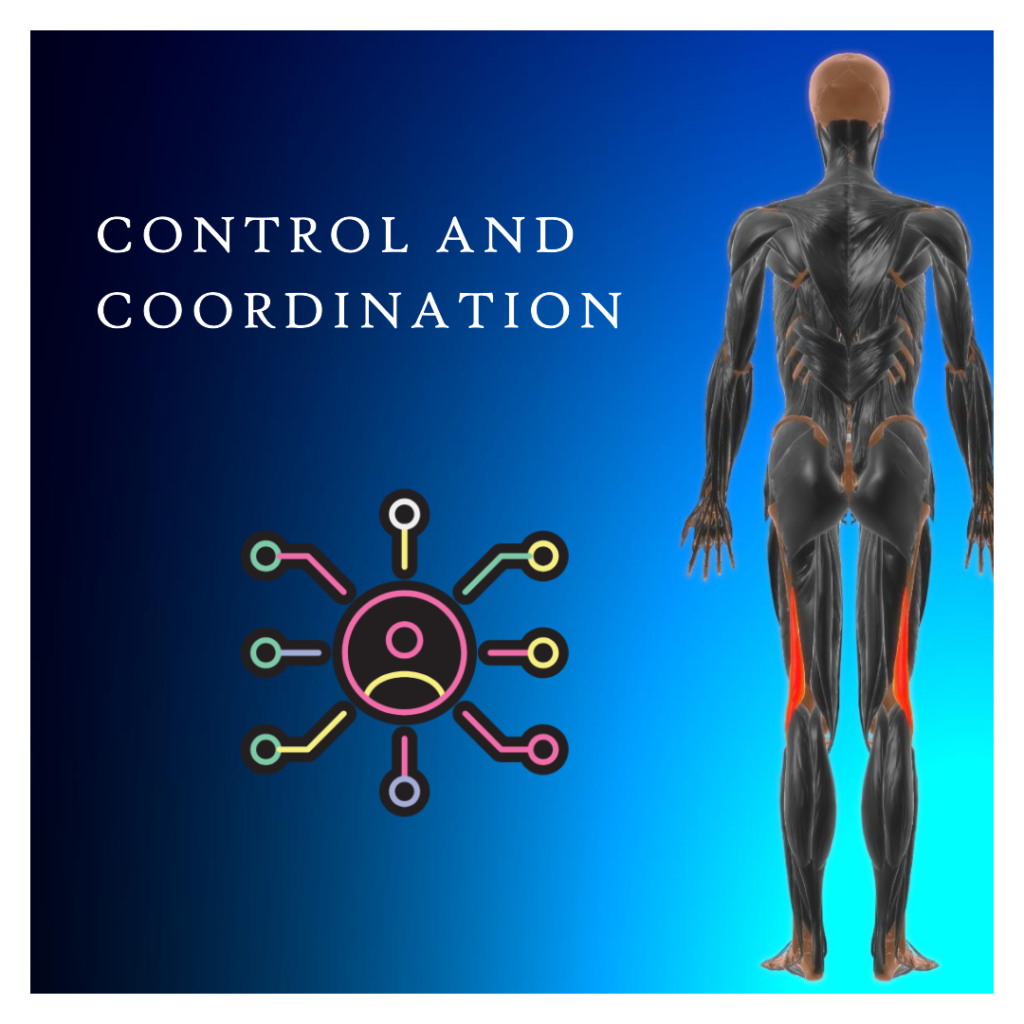
Control and Coordination Notes Class 10: The Nervous System
Movement in Organisms
Movement refers to the capability of organisms to manipulate specific body parts. When they relocate from one location to another, this process is known as locomotion. Furthermore, organisms demonstrate movements as a response to various stimuli.
Introduction to Control & Coordination
In response to diverse stimuli such as light, heat, nutrients/food, and more, organisms exhibit movement. The nervous and endocrine systems play a pivotal role in controlling and coordinating all activities in animals.
These two systems work hand in hand, with hormones serving as chemical messengers that aid the nervous system in executing various functions.
These hormones are secreted by endocrine glands. Additionally, in plants, hormones also serve as coordinators of movements, facilitating their responses to environmental cues.
The Nervous System

Types of Nervous System
Neuron
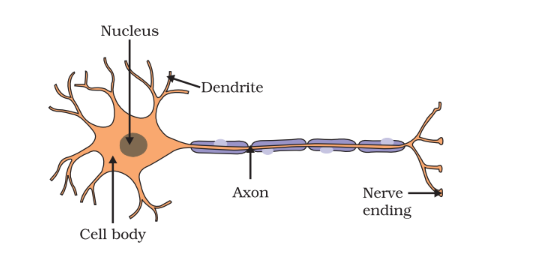
The neuron serves as the fundamental building block of the nervous system, encompassing both its structure and function.
Comprising three primary components, each neuron includes dendrites, cyton/soma/cell body, and an axon. Dendrites are responsible for receiving impulses from other neurons, while the cyton/soma processes these impulses. On the other hand, the axon is tasked with transmitting the impulse either to another neuron or to muscles, glands, and other target cells.
Neurons can exist in two forms: myelinated or non-myelinated. Myelinated neurons possess a myelin sheath, leading to faster impulse transmission compared to non-myelinated neurons. This intricate system of neurons facilitates swift and efficient communication within the nervous system.
Central Nervous System
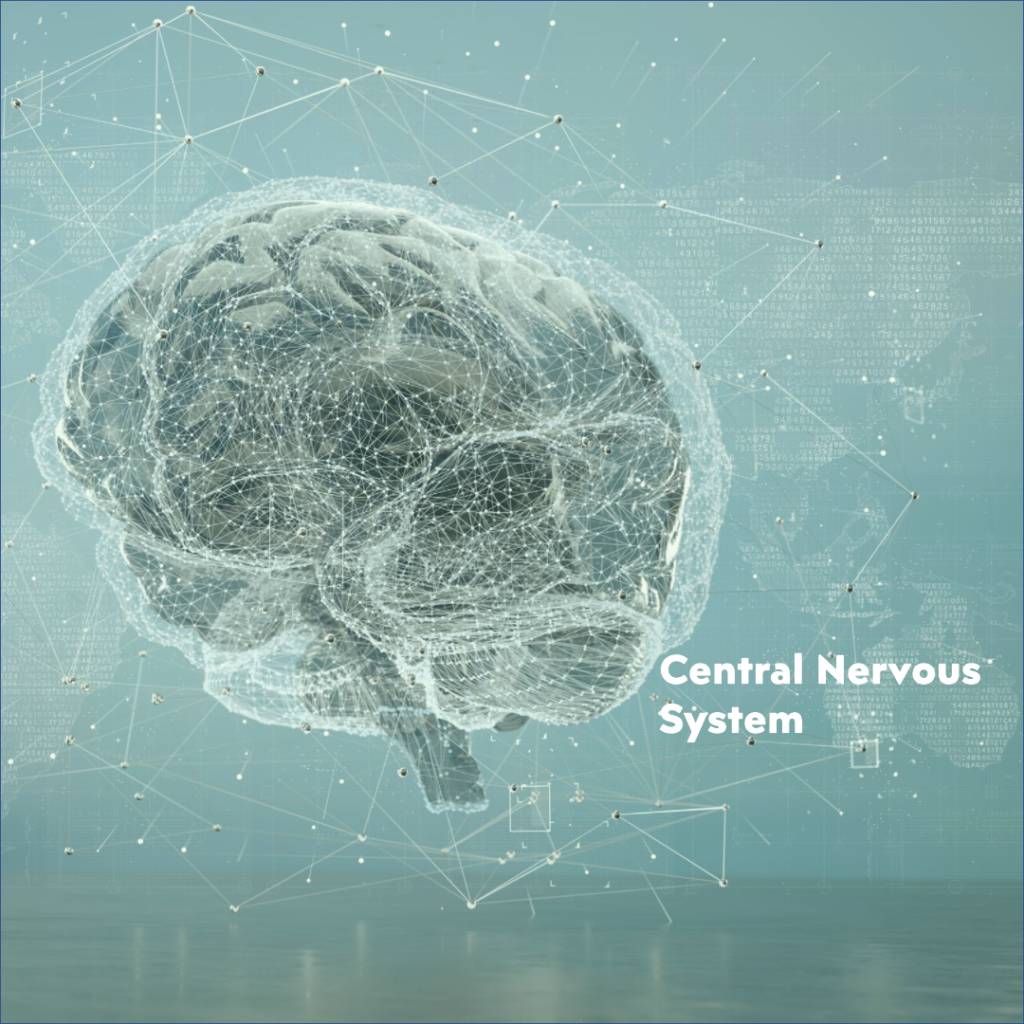
The central nervous system (CNS) comprises the brain and the spinal cord. The distinct parts of the brain fulfill various functions:
1. The cerebrum governs reasoning, logic, emotions, speech, memory, visual processing, recognition of auditory and taste stimuli, and more.
2. The cerebellum regulates and coordinates body movements, posture, and balance.
3. The pons serves as a relay station, transmitting signals from the hindbrain to the forebrain.
4. The Medulla Oblongata controls involuntary movements, including functions like vomiting, sneezing, yawning, heartbeat, breathing, blood pressure, etc.
5. The Medulla oblongata continues as the spinal cord, coursing through the vertebral column, and overseeing reflex actions.
Each part of the brain plays a vital role in maintaining bodily functions and supporting complex cognitive processes.
Peripheral Nervous System
The peripheral nervous system (PNS) is composed of nerves that emanate from both the brain and the spinal cord. In humans, this system comprises 12 cranial nerves and 31 spinal nerves.
These nerves extend throughout the body, facilitating communication between the central nervous system and various organs, muscles, and sensory receptors.
Somatic Nervous System
The somatic nervous system constitutes a component of the peripheral nervous system (PNS). It comprises the nerves responsible for controlling voluntary actions within the body.
Through the somatic nervous system, individuals can consciously and deliberately perform movements, enabling interactions with the external environment.
Autonomic Nervous System
The autonomic nervous system encompasses all the nerves within the peripheral nervous system (PNS) that oversee involuntary actions in the body. Vital functions such as respiration, heart rate, blood pressure, digestion, and more are regulated by the autonomic nervous system. It operates through two divisions known as the sympathetic and parasympathetic nervous systems.
The sympathetic nervous system readies the body for intense physical activity, often referred to as the fight-or-flight response. On the other hand, the parasympathetic nervous system exerts an opposite effect, promoting relaxation and inhibiting or slowing down many high-energy functions. These two divisions work in harmony to maintain a delicate balance in the body’s physiological responses to various situations and stimuli.
Reflex Action
A reflex is a spontaneous and involuntary reaction to stimuli, playing a crucial role in our renowned survival instinct.
Many common reflexes are a result of our well-trained and accumulated knowledge of caution that we have internalized over time.
They can manifest in various ways, such as quickly pulling back our hand when it touches an extremely hot or cold object—an action known as a reflex action. These reflexes are intricately linked to our instinctual responses, enabling swift and automatic protective measures to safeguard our well-being.
Reflex Arc
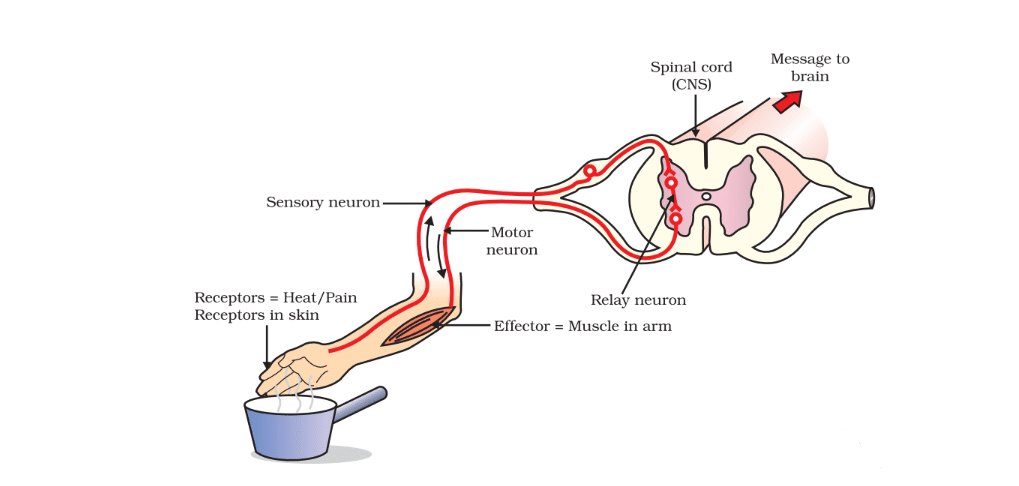
A reflex arc denotes the route taken by an electrical impulse during a reflex action.
The journey commences as the impulse travels from the receptor organ to either the spinal cord or the brain, where it undergoes processing. Once processed, the relevant information is relayed back to the appropriate muscle, prompting the action to be executed.
The components of a reflex arc encompass the receptor organ, the sensory/afferent neuron, the interneuron, the motor/efferent neuron, and the effector organ. These elements work in seamless coordination to ensure rapid and automatic responses to external stimuli, safeguarding the body from potential harm.
Protection of CNS
The brain is safeguarded by three primary layers of protection:
1. The bony skull, also known as the cranium, provides a sturdy and robust outer covering.
2. The cerebrospinal fluid acts as a cushioning and shock-absorbing layer that surrounds and supports the brain.
3. The meninges, comprising the Dura mater, Arachnoid, and Pia mater, form a protective membrane that encloses and shields the brain from potential harm.
Together, these layers form a formidable defense system, ensuring the brain’s well-being and functionality within the skull.
Plant Hormones and Movements
Plant Hormones
Hormones are responsible for orchestrating control and coordination in plants.
| Plant Hormone | Function |
|---|---|
| Auxin | It facilitates the growth of plant tissues. |
| Cytokinin | It stimulates cell division and retards cell aging. |
| Gibberellins | This hormone aids in stem growth, triggers seed germination, stimulates flowering, facilitates cell division, and supports seed development after germination. |
| Abscisic acid | It hinders growth, leading to leaf wilting, and encourages bud and seed dormancy. |
| Ethylene | This hormone is in gaseous form and induces the ripening of fruits. |
Growth Independent Movements
Movements that are unrelated to growth are referred to as nastic movements. These movements are triggered by environmental stimuli, but their direction of response is not determined by the direction of the stimulus.
The touch-me-not plant exhibits thigmonastic movement, which is a response to touch stimuli.
Growth-Related Movements in Plants
Movements that are related to growth are termed tropic movements. These movements arise in response to environmental stimuli, and the direction of their response is influenced by the direction of the stimulus.
Here are some examples of tropic movements:
1. Phototropic movement (light-dependent)
2. Geotropic movement (gravity-dependent)
3. Chemotropic movement (chemical-dependent)
4. Hydrotropic movement (water-dependent)
5. Thigmotropic movement (touch-dependent)
Geotropism
The response of plant parts to the Earth’s gravitational force is referred to as geotropism or gravitropism.
Positive geotropism is when plant parts grow towards gravity, while negative geotropism is when they grow away from gravity. For instance, roots exhibit positive geotropism as they grow towards the force of gravity, while shoots display negative geotropism by growing away from it.
Phototropism
Phototropism refers to the movement of plant parts in response to light.
Positive phototropism occurs when plant parts move towards light, while negative phototropism happens when they move away from light.
For example, stems exhibit positive phototropism as they bend towards the light source, while roots demonstrate negative phototropism by bending away from the light.
Hydrotropism
Hydrotropism refers to the movement of plant parts in response to water or moisture.
Positive hydrotropism occurs when plant parts move towards water, while negative hydrotropism happens when they move away from water.
For example, roots exhibit positive hydrotropism as they grow in search of water, such as moving towards areas with high humidity levels.
Chemotropism
Chemotropism refers to the movement of plant parts in response to chemical stimuli.
Positive chemotropism occurs when plant parts move towards the chemical source, while negative chemotropism happens when they move away from it. For example, the growth of the pollen tube towards the ovule is a demonstration of positive chemotropism, as it is attracted by chemical signals from the ovule.
Thigmotropism
Thigmotropism refers to the movement of plant parts in response to touch.
Positive thigmotropism occurs when plant parts move towards the touch stimulus, while negative thigmotropism happens when they move away from it.
For example, the movement of tendrils around a support is a demonstration of positive thigmotropism, as they respond to the touch of the support structure.
Importance of The Endocrine System for Control and Coordination Notes Class 10
Exocrine Glands
Exocrine glands are glands that release secretions through ducts, which open onto an epithelial surface.
Endocrine Glands
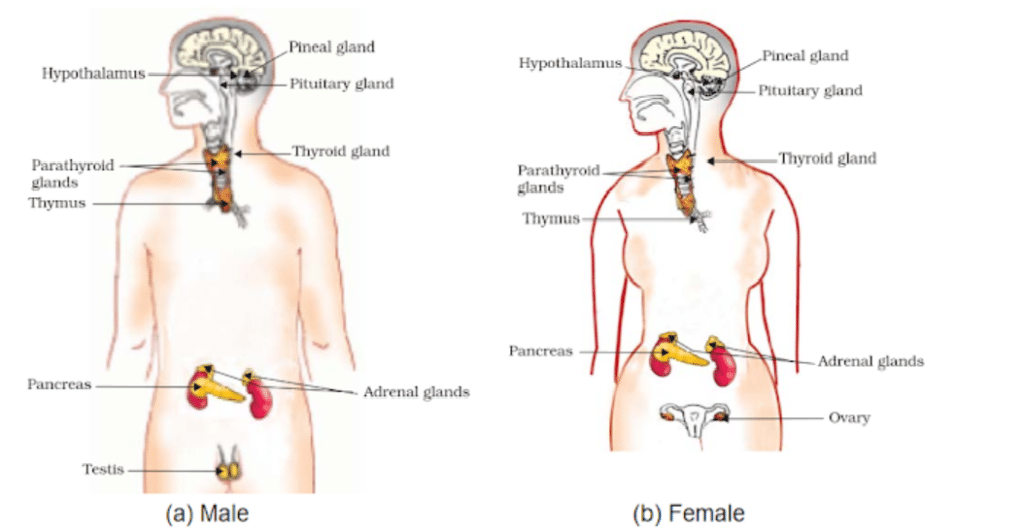
Endocrine glands in humans are ductless glands that release hormones directly into the bloodstream.
The human body houses various endocrine glands, including the pituitary, thyroid, adrenal, pineal, pancreas, ovary (female), testis (male), and more. Let’s delve deeper into the functions and roles of each of these glands below.
Pituitary Gland
Situated at the base of the brain, this gland is approximately the size of a pea.
Known as the master gland, it holds authority over the secretions of all other endocrine glands.
In addition, it releases the Growth Hormone (GH). If GH is under-secreted, it can lead to Dwarfism, while over-secretion results in Gigantism during childhood and Acromegaly in adulthood.
Thyroid Gland
Shaped like a butterfly, this gland resides in the throat region.
Its primary function involves releasing the hormone ‘Thyroxine,’ which plays a crucial role in regulating the body’s metabolism.
Iodine is an essential element required for synthesizing thyroxine within the body.
In situations of iodine deficiency, the gland under-secretes thyroxine, resulting in a condition known as goitre.
Pancreas
Located behind the stomach in the abdomen, this gland resembles a leaf in shape.
It functions as both an endocrine and exocrine gland.
As an endocrine gland, it produces two essential hormones – Insulin and glucagon. These hormones work in opposition to one another to regulate the blood sugar levels.
In its exocrine role, the gland secretes enzymes responsible for breaking down proteins, lipids, carbohydrates, and nucleic acids present in food.
Insufficient production of insulin by the pancreas can lead to diabetes, a condition characterized by abnormal blood sugar levels.
Adrenal Gland
Present in pairs above each kidney, these glands undergo a decrease in size as age advances.
They are responsible for secreting the hormone adrenaline, which plays a vital role in triggering the body’s flight or fight response during stressful situations.
Additionally, these glands also secrete noradrenaline, contributing to various physiological responses in the body.
Gonads
Gonads refer to the organs responsible for producing gametes – testes in males and ovaries in females.
In males, the testes produce the male hormone testosterone, while in females, the ovaries produce the female hormones estrogen and progesterone.
Testosterone and estrogen play crucial roles in gamete production and are responsible for the development of male and female sexual characteristics, respectively.
Progesterone is known as the pregnancy hormone, as it plays a vital role in supporting and maintaining pregnancy.
Other Endocrine Organs
In addition to the previously mentioned endocrine glands, the other endocrine organs encompass the hypothalamus, parathyroid, pineal, and thymus glands.
Read More
- Class 10 Notes for Science NCERT
- Chemical Reaction and Equation Notes Class 10 NCERT Sci. Ch.1
- Acids Bases and Salts Class 10 Notes of NCERT Science Ch. 2
- Life Process Notes Class 10 NCERT Science Chapter 5
- Class 10th How Do Organisms Reproduce Notes: Science Ch. 7
- Class 10th Heredity and Evolution Notes: NCERT Science Ch. 8
- Notes on Magnetic Effect of Electric Current Class 10 NCERT
- Human Eye and the Colourful World Notes Chapter 10 Science
- Metals and Non Metals Class 10 NCERT Science Chapter 3 Notes
- Class 10th Chapter 11 Science Notes for NCERT Students
- Notes of Our Environment Class 10: NCERT Science Chapter 13
Frequently Asked Questions on Control and Coordination Notes Class 10
What is the significance of the nervous system in control and coordination?
The nervous system plays a vital role in control and coordination as it enables the transmission of electrical impulses, facilitating communication among different body parts and the environment. It ensures swift responses to stimuli and aids in maintaining homeostasis, essential for the body’s proper functioning.
How do hormones contribute to control and coordination?
Hormones serve as chemical messengers in the endocrine system, responsible for control and coordination. They regulate various bodily functions, including growth, metabolism, and reproductive processes. By releasing hormones directly into the bloodstream, the endocrine system coordinates complex physiological responses throughout the body.
What are the key reflex actions in humans, and how do they work?
Reflex actions are involuntary responses to stimuli. Examples include the knee-jerk reflex and withdrawing a hand from a hot object. They occur through reflex arcs, involving sensory neurons, interneurons, and motor neurons. When a stimulus is detected, the impulse travels to the spinal cord or brain, which processes the information and sends a response back to the muscles, leading to the reflex action.
What are tropic movements in plants, and how do they work?
Tropic movements in plants are growth-related responses to environmental stimuli. Examples include phototropism (in response to light) and geotropism (in response to gravity). These movements are directed by the hormones auxin and gibberellin, which cause cells on the shaded side to elongate, leading to bending towards or away from the stimulus.
How does the endocrine system influence human growth and development?
The endocrine system significantly influences human growth and development. Hormones like growth hormone (GH), testosterone, and estrogen play pivotal roles in the growth of bones, muscles, and other tissues during puberty. Imbalances in these hormones can lead to growth disorders, affecting height and physical development. Additionally, thyroid hormones play a crucial role in metabolism, impacting energy levels and overall health throughout life.
Read Also:
- Chemical Reactions and Equations
- Acids, Bases and Salts
- Control and Coordination
- How Do Organisms Reproduce?
- Heredity and Evolution
- Magnetic Effects of Electric Current
- Our Environment